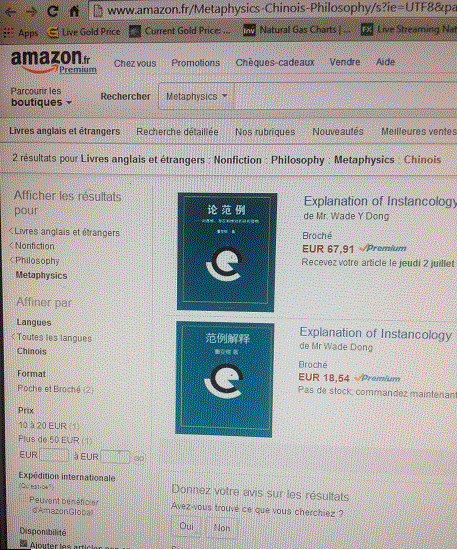Epistemology applied to Instancology
Epistemology in the Four Layers of Instancology: The Missing Key of WuXing
Introduction
Since antiquity, philosophy has grappled with the question of how we know—through experience, reason, or interpretation. Yet all classical frameworks, both Western and Eastern, have overlooked a crucial dimension of knowing: WuXing (悟性), the sudden, holistic flash of insight. Instancology is the first philosophical system to systematically theorize WuXing and to show its role not only in scientific discovery but in the ultimate fulfillment of philosophical inquiry. This is Instancology’s most original and far-reaching achievement.
---
1. AR (Absolute Relative): Empirical Knowledge—Experience of Nature
What:
The world of natural phenomena—everything that exists independently of human construction.
How We Know:
By experience, direct observation, and trial and error. This is the world of sensory engagement and empirical science.
Examples:
Aristotle’s physics: observing and cataloguing the natural world.
Shennong tasting a hundred herbs: empirical trial, sometimes at great personal risk.
The inductive regularity (“the sun will rise tomorrow”) that underlies early scientific thinking (Hume, Locke, British empiricists).
---
2. RR (Relative Relative): Rational/Constructive Knowledge—Human Civilization and Interpretation
What:
The realm of human products—language, philosophy, art, science, law, and all systems of rational inquiry and cultural achievement.
How We Know:
By reason, reflection, and social construction. Here, knowledge is created, negotiated, and systematized in the human world, culminating in the Age of Reason and the achievements of Western civilization.
Examples:
Kant: Systematizing knowledge within the bounds of reason.
Hegel: The dialectic and the unfolding of Spirit through history.
Heidegger: Existential interpretation of being.
Wittgenstein: Analysis of language, symbolism, and the limits of representation—yet still confined to the layer of human construction.
Law, literature, mathematics as social achievements.
---
3. RA (Relatively Absolute): The Laws—WuXing as the True Epistemology
What:
The domain of universal, underlying principles: laws of nature, mathematical and logical truths. These are not constructed nor directly experienced, but “discovered” in moments of insight.
How We Know:
Not through mere reason or experience, but through WuXing—the sudden, holistic illumination that reveals a truth in its entirety. This is the forgotten epistemology, the real engine behind all scientific and creative breakthrough.
Examples:
Archimedes: The “Eureka!” moment—discovery of the principle of buoyancy.
Einstein: Relativity as a leap of thought beyond existing theory.
Ramanujan: Theorems arising in intuition and dreams.
Countless scientists, artists, inventors—whose greatest contributions arose from flashes of direct insight rather than logical deduction or empirical accumulation.
Philosophy’s Limitation:
Western philosophy, from Kant and Hegel to Wittgenstein and the analytic tradition, never theorized WuXing as a distinct way of knowing, even as it drove every advance in science.
Instancology uniquely identifies, names, and locates WuXing as the essential epistemology of the RA layer.
---
4. AA (Absolute Absolute): The Unspeakable Background—Truth Beyond Knowledge
What:
The ultimate ground of all reality—the Absolute that precedes and enables every layer, but cannot itself be spoken, represented, or known.
How We Know:
We do not and cannot “know” AA in any conventional sense. All experience, reason, and even WuXing can only approach its boundary. At best, one attains a negative awareness: humility before the ineffable, the intuition of the limits of all knowing.
Significance:
AA is the final truth, the background that “shines through” all layers but remains ungraspable.
WuXing, uniquely theorized by Instancology, is the only epistemic movement that allows philosophy to approach AA—not by definition, but by a radical opening to the Absolute.
Examples:
Mystical experience (Laozi’s Dao: “The Dao that can be spoken is not the eternal Dao”).
Kant’s “thing-in-itself”—yet even more radical: not a thing at all, but the precondition of all things.
The moment of radical awakening or enlightenment, where knowledge collapses into direct presence.
---
Instancology’s Breakthrough: Crowning 2,500 Years of Western Philosophy
All prior philosophy and science, despite their towering achievements, have been confined to experience (AR), reason and construction (RR), or, at best, the rational discovery of law (RA).
The living history of civilization shows that all true breakthroughs—every scientific revolution, every genuine act of creation—came through WuXing, though it was never named or fully understood.
Instancology’s most important contribution is this:
By recognizing WuXing as a distinct and necessary epistemology, and showing that it alone allows access to both the RA layer (law, logic, structure) and the possibility of approaching AA (the Absolute), Instancology fulfills the deepest promise of philosophy—uniting knowledge, reality, and the Absolute for the first time.
